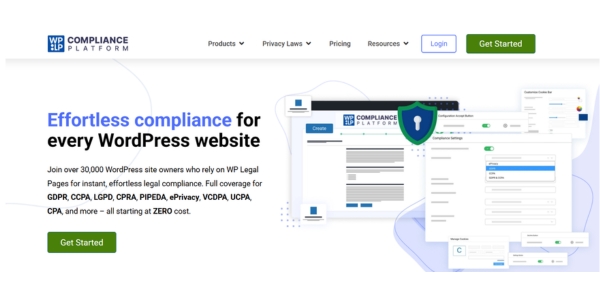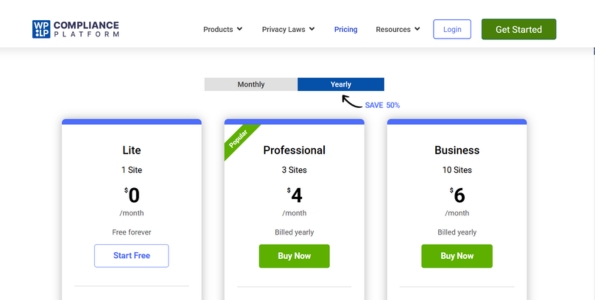Laws about privacy are always changing, and WordPress site owners need tools that can keep up. You need to have clear legal pages, a cookie banner that follows the rules, and a way to record permission that can be used in court. It’s hard to keep track of everything when you use different tools for each task. The WPLP Compliance Platform addresses this issue by integrating the creation of legal pages with consent management into a single, WordPress-friendly solution.
This review looks at how well the platform helps teams create privacy policy pages, show a cookie sign that meets GDPR cookie consent standards, and keep all consent records in one place. Also, we check to see if the WPLP Compliance Platform works for store owners and agencies that want to get things done faster without skimping on compliance.
What is the WPLP Compliance Platform
There are two tried and true tools in the WPLP Compliance Platform, which can be used together. You get a strong privacy policy maker, a flexible terms and conditions generator, and a full-featured Cookie consent manager that lets you control things down to the smallest detail. The whole platform is built around WordPress, which means it’s easy to set up, doesn’t mess up your theme, and works well with famous plugins.

You only need to use one dashboard instead of two plugins to create privacy policy pages and handle WordPress cookie consent. That simplicity cuts down on mistakes made by people, speeds up onboarding, and gives you a single source of truth for permission records.
Key Benefits at a Glance
- Use templates and smart tips to make legal pages.
- Put up a cookie banner that you can change in minutes that meets GDPR cookie consent standards.
- Use a Cookie consent manager that puts an emphasis on openness to keep track of, export, and audit user choices.
- Serve people from around the world by following the rules set by GDPR, CCPA, LGPD, and other groups.
- Avoid having multiple subscriptions that cross to save money and time.
Legal Page Creation That Scales
Make your own privacy policy and more
There should be a clear privacy policy on every website, and by answering a few short questions, the privacy policy generator in WPLP will make a document that is just right for you. After walking you through the different types of data, where to collect the data, and how long to keep them, the wizard posts the results as a WordPress page. If your business changes, you can quickly change the policy in the editor and repost.

The platform also has a privacy statement maker for businesses that want to make short statements for landing pages or product microsites. Many teams use a privacy statement generator in conjunction with a longer privacy policy, allowing users to view both a concise summary and the full policy.
Conditions and terms of generator coverage
Clear site rules keep you safe and let users know what to expect. There is a terms and conditions creator in WPLP that makes a full terms page. You can change the language about responsibility, payment, and what is and isn’t allowed to fit your business. The site also has a terms & conditions generator for teams that need a more formal style. Some brands put out both forms, using the terms & conditions generator for legal accuracy and the terms & conditions generator for an easier-to-read format.
Make a privacy policy and pages connected to it in minutes
The repeatable process is great for teams that need to create privacy policy pages for more than one brand. You can write a privacy policy, copy it for a second site, and then change the brand names, contact information, and data controllers without having to write the whole thing over again. The level of work for all clients is more consistent with this method.
Consent Management Built for WordPress
An ad for cookies that works in the real world
WPLP comes with a cookie header that you can put at the top or bottom of the viewport, and it can be set up as a modal or bar. You can localize copy, connect scripts to categories, and give users a permanent icon that lets them go back to their choices whenever they want.
You can stop scripts until you give permission when you need more control. That keeps you safe when you use tools for A/B testing, analytics, or ad trackers. The cookie banner links to the consent store, which lets you save a record for internal or external checks.
A cookie permission manager that keeps logs and gives you tools
The Cookie consent manager on the site keeps detailed records of what users choose. You can look at the total number of accepts, rejects, and choices at the category level. The Cookie consent manager also lets you revoke permission and, if necessary, make settings the same across all subdomains. During audits, these details are important because they show a clear record of when users made choices.
WordPress cookie consent and being ready for foreign use
Since a lot of teams work across countries, your website needs to be in line with different laws. This tool helps you get WordPress cookie consent in a way that respects user rights and follows local rules. For people in Europe, it allows opt-in behavior that is the same as GDPR cookie consent patterns. You can use a lighter header and still make the choices clear for other areas.

WordPress’s cookie consent tools and detailed logging give you a compliance stance that can be scaled. You avoid setups that aren’t constant, which can cause experiences to be uneven or records to be lost.
Advanced Features That Matter
- Templates for standard policies that have been looked over by lawyers.
- Smart fields and tags that make brand names and addresses different in different papers.
- Regional behavior to change the sign to fit the rules in that area.
- Consent storage is intended for auditability with export options.
- Ways for analytics and marketing tools to connect that need the right consent signals.
These parts let you move quickly while lowering the risk. Instead of writing your own code or depending on a bunch of different plugins, you use logic that is already built in.
Setup, User Experience, and Speed
WPLP can be added to WordPress just like any other tool. Once it’s been activated, a simple onboarding wizard will help you choose document templates and share them. It’s easier for first-time users to understand because the interface has simple labels and keeps settings grouped by job.
The platform uses assets that are efficient and only gets what it needs to run quickly. In real life, sites still do well on speed tests. The ad starts up quickly, and permission checks happen before scripts run. This balance is important for both SEO and sales.
Value and Price 
WPLP has a large free tier that lets you try out the main features. The paid plans come with more themes, wider scans, and more traffic. When you look at how much different legal generators and third-party consent tools cost, the value of the whole package stands out.
The agencies gain the most. You can make it easier for many clients to understand your privacy policies by using the terms and conditions generator to post terms and keep your GDPR cookie consent behavior consistent with one cookie banner framework. That cuts down on help tickets and makes sure quality is always the same.
Pros and cons
Pros
- Put all legal papers and consent controls on one platform that is built on WordPress.
- The privacy policy generator and adjustable term templates make it easy to make documents quickly.
- Different banner styles let you show a cookie banner that is easy to see and understand.
- Strong logging through the Cookie permission manager to keep records that can be used in court.
- An easy way to set up WordPress cookie consent that meets GDPR consent standards.
- Fast speed that keeps SEO and UX safe.
Cons
- WordPress only, which means it can’t be used on stacks that aren’t WordPress.
- For very small teams, a rich setup can feel hard to use.
- Some brands might want a law review that isn’t based on templates.
Use Cases
Small businesses and people who work alone
With the privacy policy generator, site owners can do everything at once: start a site, post legal pages, and add a cookie banner. After that, they can trust the Cookie consent manager to keep track of records and send them as needed. They can go back to the terms & conditions generator and add more sections if they need to in the future.
Firms and independent workers
Agencies often take care of a lot of sites. With WPLP, they can create privacy policy content more quickly, and the terms and conditions creator helps them stick to standards. They can also make sure that all of a portfolio’s WordPress cookie agreement experiences are the same. The Cookie Consent Manager gives them a central way to do checks and report on clients.
eCommerce and membership sites
For orders, subscriptions, and personalization, stores and communities gather personal information. The templates and agreement tools on the platform help these sites follow the rules without hurting the user experience. The privacy statement generator makes short notes for checkout or signup pages, and the cookie banner keeps tracking safe.
Practical Tips for Implementation
- Put scripts into groups before you start. Put analytics in charge of performance, ads in charge of promotion, and so on.
- Write short banner text that tells people what will happen if they accept or refuse.
- Put out both a long policy from the privacy policy generator and a short notice from the privacy statement maker so that people can read them however they like.
- If you do business in more than one area, set up the banner so that it follows GDPR cookie permission rules in the EU and has a less strict experience in other areas.
- Put a link to the terms and conditions you made with the terms & conditions generator at the end of your website. You should also share the version that the terms and conditions generator made if you want to give some people an easier option.
SEO Advantages
Compliance and SEO often touch each other. Search engines like pages that load quickly, are easy to use, and are careful with data. Clean markup and the platform’s performance rating are both good for Core Web Vitals. A clear banner about cookies and clear rules help people believe you, which can lead to better engagement over time.
You can target useful queries from a content point of view. The privacy policy maker may help your policy pages rank for searches that are related to your brand. People who want to know more about your tracking choices may visit your WordPress cookie consent guide. These things help build credibility and get people to buy.
Conclusion
When WordPress site owners use the WPLP Compliance Platform, they can easily make legal pages and handle consent. It takes the place of a bunch of tools with a single process. Using the terms & conditions generator, you can quickly create a privacy policy, post terms, and run a cookie banner that is in line with the law with the help of a strong Cookie consent manager. The same stack helps you make sure that WordPress cookie consent and GDPR cookie consent work the same way in all areas.
If you want fewer moving parts, faster starts, and better audit readiness, this platform should be near the top of your list. Please start with the free plan to make sure it works for you. As your business grows, you can upgrade to get themes, traffic limits, and more advanced controls.



